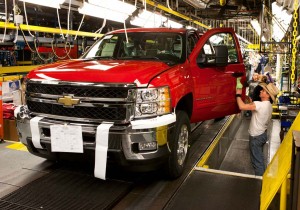
Growing demand from small businesses for heavy-duty pickups leads GM to add a third shift at its Flint plant.
General Motors plans to add a third shift at truck assembly plant in Flint, Mi. to build heavy-duty pickup trucks, largely for commercial customers – a move that should come as good news to 750 workers currently on layoff.
But 3,000 Ford workers at a plant near the company’s headquarters have gotten less positive news, learning they will be temporarily idled, next week, ironically because increasing demand has led to a shortage of key powertrain components.
Mark Reuss, GM President – North America, said the automaker is satisfied demand for the trucks is growing and there are ample customers for the heavy-duty trucks which, in turn, suggest there’s growing movement in the economy.
“Adding a third shift is a response to customer demand for heavy-duty pickups, which most people use to tow, haul and plow,” said Mark Reuss.
Flint Assembly currently employs nearly 2,100 hourly and salaried employees and operates two production shifts. In 2010 the plant produced 115,000 trucks, the majority of them regular and crew-cab versions of the heavy-duty Silverado and Sierra. Last year, the plant added production of regular and crew-cab version of the light-duty Silverado.
“We are pleased that GM is adding jobs to the Flint plant. These additional jobs are further evidence of the success of the domestic automotive industry after many in the country said it was dead,” said United Auto Workers Union Vice President Joe Ashton, who directs the union’s General Motors Department.
The added shift is expected to start in the third quarter of 2011, with employees starting to arrive at Flint Assembly in the second quarter to train and prepare for the production increase.
Chevrolet sales to small businesses have increased for three consecutive months. In the fourth quarter of 2010, Chevrolet dealers recorded a 36% increase in small business sales, almost three times the increase for the industry overall, indicating that small businesses across the U.S. are beginning to reinvest.
“Small businesses put off capital expenditures such as vehicle purchases in order to weather the economic storm,” said Don Johnson, GM vice president, U.S. Sales Operations. “With the continuing improvement in consumer spending, and improving profitability of these businesses, we’re beginning to see a significant influx of small business buyers to Chevrolet showrooms.”
As Ford has learned, there can be a downside to the rebound in demand for trucks. The maker says it has run into a shortage of components for two of the new powertrains – a 3.7-liter V6 and the 3.5-liter EcoBoost – used in its full-size F-150 pickup. As a result, it will temporarily idle the Dearborn Truck Plant while an unnamed supplier struggles to catch up.
Part of the problem facing Ford – as well as its rivals – is that suppliers are still struggling to rebuild their own operations, slashed during the recent recession. More than a score of Tier I parts makers filed for Chapter 11 during the depths of the downturn.
The loss of production is a serious setback for Ford, which saw demand for the best-selling F-Series surge 27% in 2010. The maker was anticipating even further growth this year, basing that on the improving economy and demand created by the pickup line’s new powertrains.
Business owners’ increased confidence, combined with the increasing age of U.S. vehicles, suggests small-business sales will continue to grow. According to RL Polk and Company, the average vehicle age has increased to 10.2 years through October, 2009 – the first time that the American vehicle fleet has ever been more than 10 years old.
